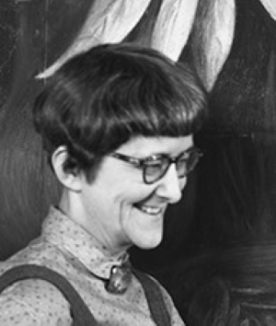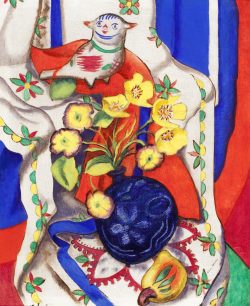Ethel Spears, detail from an undated photograph, circa 1956, courtesy The Field Museum, GN79200.

Ethel Spears 1903–1974
Chicago native Ethel Spears began her art training in the textile design program at the Art Institute of Chicago and received her first solo exhibition there in 1923. She soon began studying fine art at the school, counting among her teachers progressive painter John Warner Norton. Through him, Spears received a commission to paint murals for the museum’s tea room, a project that established her locally as a promising young talent. Around 1925 Spears studied drawing with Russian sculptor Alexander Archipenko in Woodstock, New York, and in New York City, where she also studied lithography at the Art Students League and printing design at New York University while supporting herself as a switchboard operator. Refusing work as a textile designer, Spears took on book illustration assignments and received a solo exhibition of her drawings at the Weyhe Gallery. She also maintained her ties to Chicago: she exhibited in the Art Institute’s annual watercolor and “Chicago and Vicinity” shows (winning a prize in the latter in 1926), showed with the All-Illinois Society of Fine Arts in 1928, and contributed drawings to the short-lived magazine The Chicagoan. Spears spent four months in Paris in 1929–1930. Stopping briefly in New York on her way home, she won first prize in the 1930 annual exhibition of the Studio Club of the YWCA. Spears resumed her studies at the Art Institute, where she became an instructor in 1937. She taught painting, ceramics, enameling, and printmaking for almost a quarter of a century.
In 1934, local art critic Clarence J. Bulliet described Spears as “one of the alert art intellects in contemporary Chicago.”i Her lively multifigural paintings, with their naive allover compositions and droll anecdote, reflected a contemporary artistic trend toward accessible images of ordinary people and daily life. Under the sponsorship of the WPA’s Illinois Art Project, Spears produced numerous oil and watercolor paintings as well as murals, the latter mostly for Chicago-area educational institutions ranging from elementary schools to the University of Illinois College of Medicine. Spears was active in the Chicago Society of Artists and other local institutions. She made at least two trips to Southern California, one in the early 1930s and the other in 1944, when she exhibited with the San Diego Fine Arts Society and the La Jolla Art Club.
In the late 1950s, Spears began to suffer the effects of what may have been lead poisoning from the pigments she used in her artwork. Retiring from the Art Institute’s faculty, she moved with her companion, fellow artist Kathleen Blackshear, to the latter’s hometown of Navasota, Texas. Spears continued to paint her distinctive playful scenes chronicling everyday life. Ever loyal to her hometown, she served as treasurer of the Chicago Society of Artists the year before her death.
Wendy Greenhouse, PhD
i C. J. Bulliet, “Artists of Chicago Past and Present. No. 82: Ethel Spears,” Chicago Daily News, May 1, 1937.
